- 线程基本概念
线程是一个程序内部的顺序控制流,也可以将线程看做是一个程序中不同的执行路径。
- 线程和进程的基本区别
进程可以看做是静态的,在一个程序执行之前,在内存中会生成这个进程的代码空间和数据空间,并且一个进程的代码空间和数据空间一般情况下是独占的,不和其他进程共享(如果不进行交互的话);当这个程序开始执行,在这个进程中会产生一个主线程,然后这个主线程开始执行,如果有需要,这个主线程还会产生多个子线程并行执行,在宏观上看,这个进程开始执行了(实际上进程内部运行的是线程)。
- 进程有独立的代码和数据空间,而同一类线程共享代码段和数据空间,但是线程也有自己独立的运行栈和程序计数器(如果没有的话,线程并行运行起来就会出问题)。因此,进程间的相互切换的代价大于线程间的相互切换。
- 多线程和多进程:多线程是同一个程序中(同一类线程)多个不同的顺序流同时执行;多进程是操作系统中同时执行多个任务(程序)。
- 如何产生一个并行执行的线程
一,继承Thread类
package hq.org;
public class TestThread1 extends Thread{
private boolean flag = true;
public static void main( String args[])
{
TestThread1 t = new TestThread1();
t.start();
for( int i=0; i<100; i++)
{
try {
Thread.sleep(1000);
} catch (InterruptedException e) {
e.printStackTrace();
}
System.out.println("I'm MainThread.");
}
t.endSubThread();
System.out.println("MainThread Stoped.");
}
public void run()
{
while( this.flag )
{
try {
Thread.sleep(1000);
} catch (InterruptedException e) {
e.printStackTrace();
}
System.out.println("----I'm SubThread.");
}
System.out.println("----SubThread Stoped.");
}
public void endSubThread()
{
this.flag = false;
}
}
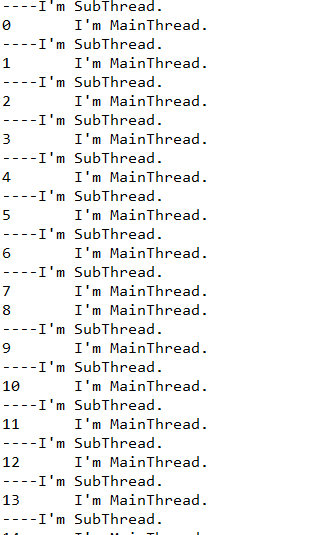
二,实现runnable接口
package hq.org;
public class TestThread {
public static void main(String args[])
{
Runner1 r = new Runner1();
Thread t1 = new Thread( r );
t1.start(); //开始子线程
for( int i=0; i<50; i++) //主线程
{
try {
Thread.sleep(500);
} catch (InterruptedException e) {
e.printStackTrace();
}
System.out.println(i + " I'm MainThread.");
}
r.endThread(); //停止子线程
}
}
class Runner1 implements Runnable
{
private boolean flag = true; //标识线程是否运行
@Override
public void run() { //重写run方法
while( flag )
{
try {
Thread.sleep(500);
} catch (InterruptedException e) {
// TODO Auto-generated catch block
e.printStackTrace();
}
System.out.println("-------I'm SubThread.");
}
}
public void endThread() { //使得线程停止
this.flag = false;
}
}
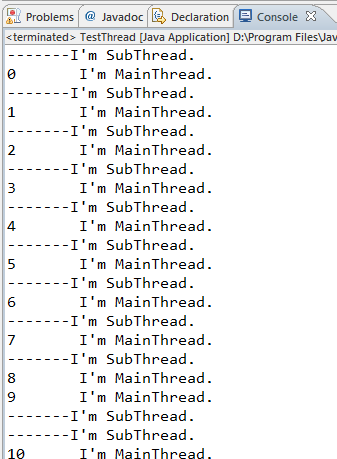
注意,这里对于产生一个新的进程,调用的都是start方法,要是直接调用run方法的话,那仅仅相当于调用某个方法,而不会产生一个新的进程去执行run方法。
除此之外,实现Runnable接口的方式比直接继承Thread类的方式要灵活。
- sleep,join和yield方法
sleep方法:使线程暂停n个毫秒
join方法:线程1掉用线程2的join方法,线程1将暂停等待线程2执行完,然后再接着往下执行
yeild方法:让步方法,暂时让出一下占用到的时间片,供其他线程使用
测试Join方法:
package hq.org;
public class TestJoin {
public static void main(String[] args) {
MyThread2 t1 = new MyThread2("Thread 2");
t1.start();
for( int i=0; i<3; i++)
{
try {
Thread.sleep(1000);
} catch (InterruptedException e) {
e.printStackTrace();
}
System.out.println("i am main thread run with Thread2.");
}
try {
t1.join();
} catch (InterruptedException e) {
}
for (int i = 1; i <= 10; i++) {
try {
Thread.sleep(1000);
} catch (InterruptedException e) {
e.printStackTrace();
}
System.out.println("i am main thread run alone.");
}
}
}
class MyThread2 extends Thread {
MyThread2(String s) {
super(s);
}
public void run() {
for (int i = 1; i <= 10; i++) {
System.out.println("i am " + getName());
try {
sleep(1000);
} catch (InterruptedException e) {
return;
}
}
}
}
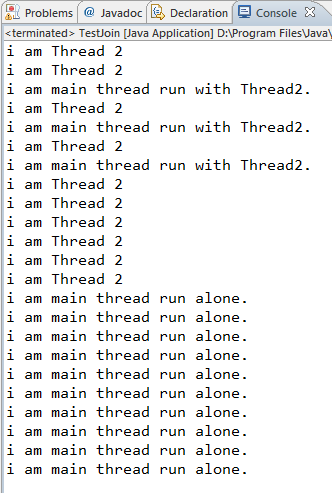
测试yeild方法:
package hq.org;
public class TestYield {
public static void main(String[] args) {
MyThread3 t1 = new MyThread3("t1");
MyThread3 t2 = new MyThread3("t2");
t1.setPriority(1);
t2.setPriority(5);
t1.start();
t2.start();
}
}
class MyThread3 extends Thread {
MyThread3(String s) {
super(s);
}
public void run() {
for (int i = 1; i <= 100; i++) {
System.out.println(getName() + ": " + i);
if (i % 10 == 0) {
yield();
}
}
}
}
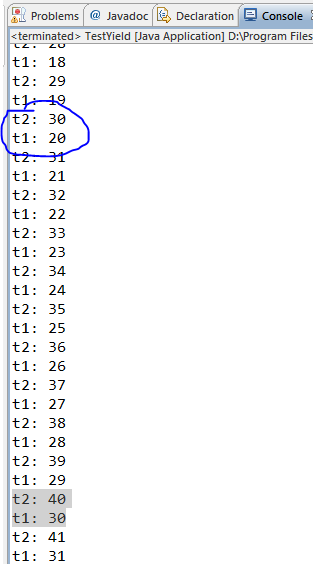
- 线程同步
package hq.org;
public class TestSync implements Runnable {
Timer timer = new Timer();
public static void main(String[] args) {
TestSync test = new TestSync();
Thread t1 = new Thread(test);
Thread t2 = new Thread(test);
t1.setName("t1");
t2.setName("t2");
t1.start();
t2.start();
}
public void run() {
timer.add(Thread.currentThread().getName());
}
}
class Timer {
private static int num = 0;
public void add(String name) {
num++;
try {
Thread.sleep(1);
} catch (InterruptedException e) {
}
System.out.println(name + ", 你是第" + num + "个使用timer的线程");
}
}
不加synchronized关键字:

加synchronized关键字:
可能是打印不叫耗时,在一个线程对Timer对象里的num值自增1次后,还没来得及打印,另外一个线程又一次调用add方法,将num值再次增1,所以两次打印出来得结果都是2,如果要让这个程序合理的运行,可以对Timer类的add方法加上synchonized关键字修饰。
- 一个简单的死锁
package hq.org;
public class TestDeadLock implements Runnable {
public int flag = 1;
//两个临界资源
static Object o1 = new Object(), o2 = new Object();
public void run() {
System.out.println("线程" + flag + "启动。。。");
if (flag == 1) {
//线程1,锁住资源1
synchronized (o1) {
System.out.println("线程1,锁住资源1");
try {
Thread.sleep(500);
} catch (Exception e) {
e.printStackTrace();
}
//线程1,锁住资源2
synchronized (o2) {
System.out.println("线程1,锁住资源2");
}
System.out.println("线程1结束。");
}
System.out.println("");
}
if (flag == 0) {
//线程2,锁住资源2
synchronized (o2) {
System.out.println("线程2,锁住资源2");
try {
Thread.sleep(500);
} catch (Exception e) {
e.printStackTrace();
}
//线程2,锁住资源1
synchronized (o1) {
System.out.println("线程2,锁住资源1");
}
System.out.println("线程2结束。");
}
}
}
public static void main(String[] args) {
TestDeadLock td1 = new TestDeadLock();
TestDeadLock td2 = new TestDeadLock();
td1.flag = 1;
td2.flag = 0;
Thread t1 = new Thread(td1);
Thread t2 = new Thread(td2);
t1.start();
t2.start();
}
}
死锁结构图:
- 一个简单的生产者和消费者程序
package hq.org;
public class MyProducerConsumer {
public static void main( String args[]){
SynicStack synicStack = new SynicStack();
Consummer cc = new Consummer(synicStack);
Producer pp = new Producer(synicStack);
Thread tc1 = new Thread( cc );
Thread tc2 = new Thread( cc );
Thread tp = new Thread( pp );
tp.start();
tc1.start();
tc2.start();
}
}
class SynicStack {
private final int stackLen = 10;
private int[] res = new int[stackLen];
private int top = -1;
public synchronized void push(int res) {
while (stackLen-1 == top) {
// 如果栈满,等待
try {
this.wait();
} catch (InterruptedException e) {
e.printStackTrace();
}
}
top++;
this.res[top] = res;
// 唤醒其他进程
this.notifyAll();
System.out.println("------Stack Length: " + top);
}
public synchronized int pop() {
int ret = 0;
while (-1 == top) {
try {
this.wait();
} catch (InterruptedException e) {
e.printStackTrace();
}
}
ret = this.res[top];
top--;
// 唤醒其他进程
this.notifyAll();
System.out.println("------Stack Length: " + top);
return ret;
}
}
class Consummer implements Runnable {
private final int numOfconsume = 20;
private SynicStack synicStack = null;
public Consummer(SynicStack ss) {
this.synicStack = ss;
}
@Override
public void run() {
for (int i = 0; i < numOfconsume; i++) {
int getRes = this.synicStack.pop();
try {
Thread.sleep(1000);
} catch (InterruptedException e) {
e.printStackTrace();
}
System.out.println("consume Res: " + getRes);
}
}
}
class Producer implements Runnable {
private final int numOfproduce = 40;
private SynicStack synicStack = null;
public Producer(SynicStack ss) {
this.synicStack = ss;
}
public void run() {
for (int i = 0; i < numOfproduce; i++) {
synicStack.push(i);
try{
Thread.sleep(50);
} catch (InterruptedException e){
e.printStackTrace();
}
System.out.println(i + " was produced.");
}
}
}
- 一个线程协作的例子
爸爸给女儿和儿子喂水果。爸爸随机挑选橘子或者苹果,将橘子剥皮或者将苹果削皮放在盘子中,剥皮的速度比较快,而削皮的时间比较慢。女儿只吃橘子,儿子只吃苹果(当然我们假设女儿和儿子永远也吃不饱)。盘子只能装下3个水果。儿子吃得比较快,女儿吃得比较慢。
编程模拟该过程:
(PS:这里http://blog.csdn.net/he_qiao_2010/article/details/8762387有linux C 对这个例子的进程实现)
简单分析
信号量:
int accessplate = 1; //表示访问盘子的信号量
int apple = 0; //苹果个数
int orange = 0; //橘子
int emptyplates = 3; //空盘子
这个例子的C代码进程实现,见“linux进程协作-一个小例子”。
这里用线程来模拟:
临界资源3个盘子,这里用一个字符串数组来表示:
String[]plates = new String[3];
每个进程对盘子进行访问的时候,对其加锁。
注:
1.如果用synchronized关键字修饰一个对象,则在程序执行的任意时刻,都只能由某一个线程去访问它,如果用synchronized关键字修饰一个方法,表示整个方法为同步方法。
2.Sleep和Wait都可以使线程等待一定的毫秒数,但是Sleep在等待过程中不释放对象锁,而wait在等待过程中释放对象锁。
代码:
package hq.org;
public class EateFruits {
public static void main(String args[]) {
Plates fruitPlates = new Plates();
Father father = new Father(fruitPlates);
Daughter daughter = new Daughter(fruitPlates);
Son son = new Son(fruitPlates);
Thread fThread = new Thread(father);
Thread dThread = new Thread(daughter);
Thread sThread = new Thread(son);
fThread.start();
dThread.start();
sThread.start();
//主线程每隔2秒打印出盘子的情况。
while (true) {
try {
Thread.sleep(2000);
} catch (InterruptedException e) {
e.printStackTrace();
}
fruitPlates.printPlates();
}
}
}
class Plates {
private static int numOfApple;
private static int numOfOrange;
private static int numOfEmptyPlates;
public Plates() {
numOfApple = 0;
numOfOrange = 0;
numOfEmptyPlates = 3;
}
//打印出盘子中的情况
public void printPlates() {
System.out.println( "plates:" + numOfApple + " apples," + numOfOrange + " oranges,"
+ numOfEmptyPlates + " empty plates.");
}
public synchronized void eatAnApple() {
while (0 == numOfApple ) {
//如果没有苹果,等待随机毫秒数,然后重新检测numOfApple值
try {
this.wait((long) (Math.random()*100));
} catch (InterruptedException e) {
// TODO Auto-generated catch block
e.printStackTrace();
}
}
numOfApple--;
numOfEmptyPlates++;
//拿到苹果后,唤醒其他正沉睡的线程。
this.notifyAll();
//吃苹果的时间
try {
Thread.sleep(1000);
} catch (InterruptedException e) {
e.printStackTrace();
}
System.out.println("Son Eat an Apple.");
}
public synchronized void eatAnOrange() {
while (0 == numOfOrange ) {
try {
this.wait((long) (Math.random()*100));
} catch (InterruptedException e) {
// TODO Auto-generated catch block
e.printStackTrace();
}
}
numOfOrange--;
numOfEmptyPlates++;
this.notifyAll();
try {
Thread.sleep(2000);
} catch (InterruptedException e) {
e.printStackTrace();
}
System.out.println("Daughter Eat an orange.");
}
public synchronized void addAnApple() {
while (3 == numOfApple || 0 == numOfEmptyPlates) {
try {
this.wait((long) (Math.random()*100));
} catch (InterruptedException e) {
// TODO Auto-generated catch block
e.printStackTrace();
}
}
numOfApple++;
numOfEmptyPlates--;
this.notifyAll();
try {
Thread.sleep(500);
} catch (InterruptedException e) {
e.printStackTrace();
}
System.out.println("Father Add an Apple.");
}
public synchronized void addAnOrange() {
while (3 == numOfOrange || 0 == numOfEmptyPlates) {
try {
this.wait( (long) (Math.random()*100) );
} catch (InterruptedException e) {
// TODO Auto-generated catch block
e.printStackTrace();
}
}
numOfOrange++;
numOfEmptyPlates--;
this.notifyAll();
try {
Thread.sleep(500);
} catch (InterruptedException e) {
e.printStackTrace();
}
System.out.println("Father Add an orange.");
}
}
class Daughter implements Runnable {
private static Plates plates = null;
public Daughter(Plates pl) {
Daughter.plates = pl;
}
@Override
public void run() {
while (true) {
synchronized (plates) {
plates.eatAnOrange();
}
}
}
}
class Son implements Runnable {
private static Plates plates = null;
public Son(Plates pl) {
Son.plates = pl;
}
@Override
public void run() {
while (true) {
synchronized (plates) {
Son.plates.eatAnApple();
}
}
}
}
class Father implements Runnable {
private static Plates plates = null;
public Father(Plates pl) {
Father.plates = pl;
}
@Override
public void run() {
while (true) {
synchronized (plates) {
// is Apple(40%)
if ((int) (Math.random() * 100) % 100 + 1 > 60) {
try {
Thread.sleep(250);
} catch (InterruptedException e) {
e.printStackTrace();
}
Father.plates.addAnApple();
}
// is Orange(60%)
else {
try {
Thread.sleep(250);
} catch (InterruptedException e) {
e.printStackTrace();
}
Father.plates.addAnOrange();
}
}
}
}
}








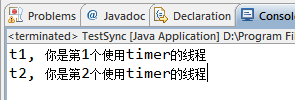
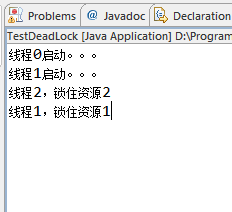
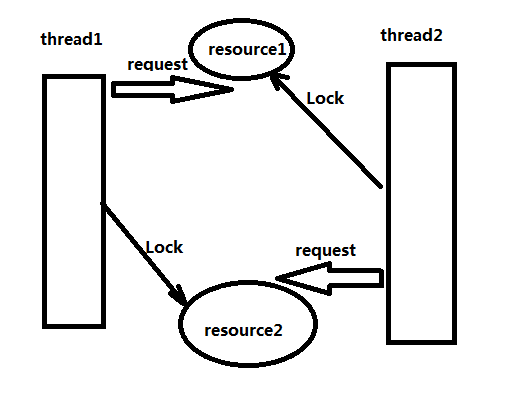

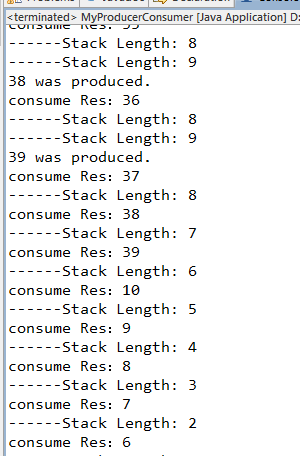
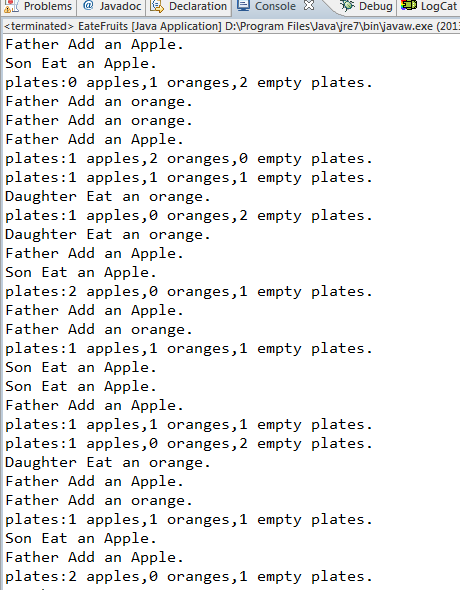














 976
976

 被折叠的 条评论
为什么被折叠?
被折叠的 条评论
为什么被折叠?








